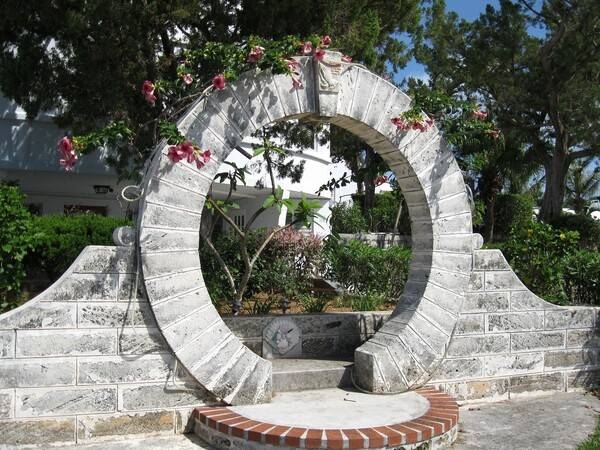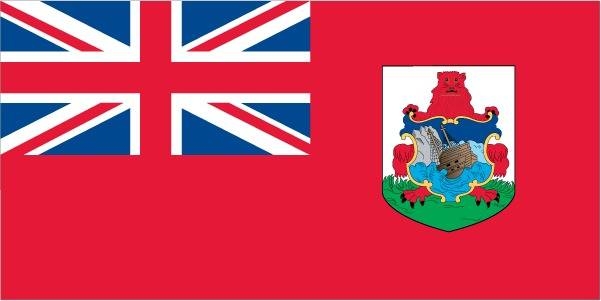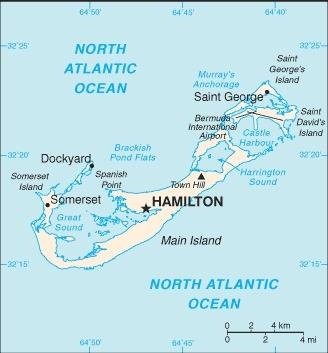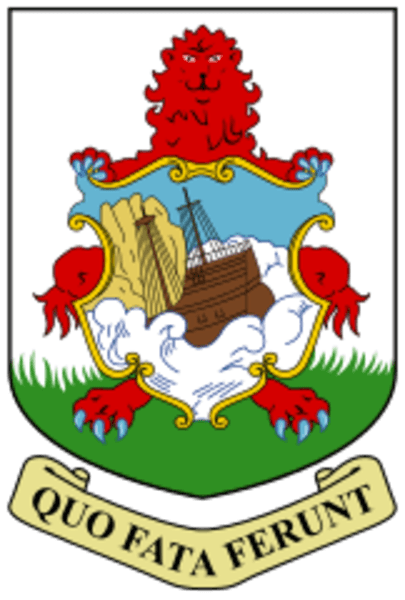Introduction
Background
Bermuda was first settled in 1609 by shipwrecked English colonists heading for Virginia. Self-governing since 1620, Bermuda is the oldest and most populous of the British overseas territories. Vacationing to the island to escape North American winters first developed in Victorian times. Tourism continues to be important to the island's economy, although international business has overtaken it in recent years. Bermuda has also developed into a highly successful offshore financial center. A referendum on independence from the UK was soundly defeated in 1995.
Visit the Definitions and Notes page to view a description of each topic.
Geography
Location
North America, group of islands in the North Atlantic Ocean, east of South Carolina (US)
Geographic coordinates
32 20 N, 64 45 W
Map references
North America
Area - comparative
about one-third the size of Washington, DC
Land boundaries
total: 0 km
Coastline
103 km
Maritime claims
territorial sea: 12 nm
exclusive economic zone: 200 nm
exclusive fishing zone: 200 nm
Climate
subtropical; mild, humid; gales, strong winds common in winter
Terrain
low hills separated by fertile depressions
Elevation
highest point: Town Hill 79 m
lowest point: Atlantic Ocean 0 m
Natural resources
limestone, pleasant climate fostering tourism
Land use
agricultural land: 14.8% (2018 est.)
arable land: 14.8% (2018 est.)
permanent crops: 0% (2018 est.)
permanent pasture: 0% (2018 est.)
forest: 20% (2018 est.)
other: 65.2% (2018 est.)
Population distribution
relatively even population distribution throughout
Natural hazards
hurricanes (June to November)
Geography - note
consists of about 138 coral islands and islets with ample rainfall, but no rivers or freshwater lakes; some land was leased by the US Government from 1941 to 1995
People and Society
Nationality
noun: Bermudian(s)
adjective: Bermudian
Ethnic groups
African descent 52%, White 31%, mixed 9%, Asian 4%, other 4% (2010 est.)
Languages
English (official), Portuguese
Religions
Protestant 46.2% (includes Anglican 15.8%, African Methodist Episcopal 8.6%, Seventh Day Adventist 6.7, Pentecostal 3.5%, Methodist 2.7%, Presbyterian 2.0%, Church of God 1.6%, Baptist 1.2%, Salvation Army 1.1%, Brethren 1.0%, other Protestant 2.0%), Roman Catholic 14.5%, Jehovah's Witness 1.3%, other Christian 9.1%, Muslim 1%, other 3.9%, none 17.8%, unspecified 6.2% (2010 est.)
Age structure
0-14 years: 16.7% (male 6,053/female 5,928)
15-24 years: 11.88% (male 4,290/female 4,235)
25-54 years: 35.31% (male 12,758/female 12,575)
55-64 years: 16.37% (male 5,560/female 6,185)
65 years and over: 19.74% (male 6,032/female 8,134) (2020 est.)

Dependency ratios
total dependency ratio: 52.9
youth dependency ratio: 22.8
elderly dependency ratio: 30.1
potential support ratio: 3.3 (2021)
Median age
total: 43.6 years
male: 41.6 years
female: 45.7 years (2020 est.)
Population distribution
relatively even population distribution throughout
Urbanization
urban population: 100% of total population (2023)
rate of urbanization: -0.2% annual rate of change (2020-25 est.)
Major urban areas - population
10,000 HAMILTON (capital) (2018)
Sex ratio
at birth: 1.05 male(s)/female
0-14 years: 1.05 male(s)/female
15-24 years: 1.06 male(s)/female
25-54 years: 1.02 male(s)/female
55-64 years: 0.91 male(s)/female
65 years and over: 0.6 male(s)/female
total population: 0.95 male(s)/female (2022 est.)
Infant mortality rate
total: 2.19 deaths/1,000 live births
male: 2.51 deaths/1,000 live births
female: 1.86 deaths/1,000 live births (2022 est.)
Life expectancy at birth
total population: 82.04 years
male: 78.96 years
female: 85.28 years (2022 est.)
Drinking water source
improved: urban: 99.9% of population
rural: NA
total: 99.9% of population
unimproved: urban: 0.1% of population
rural: NA
total: 0.1% of population (2020)
Sanitation facility access
improved: urban: 99.9% of population
rural: NA
total: 99.9% of population
unimproved: urban: 0.1% of population
rural: NA
total: 0.1% of population (2020)
Literacy
total population: NA
male: NA
female: NA
School life expectancy (primary to tertiary education)
total: 13 years
male: 12 years
female: 13 years (2015)
Youth unemployment rate (ages 15-24)
total: 29.3%
male: 29.7%
female: 29% (2014 est.)
Environment
Environment - current issues
dense population and heavy vehicle traffic create serious congestion and air pollution problems; water resources scarce (most obtained as rainwater or from wells); solid waste disposal; hazardous waste disposal; sewage disposal; overfishing; oil spills
Air pollutants
carbon dioxide emissions: 0.61 megatons (2016 est.)
Climate
subtropical; mild, humid; gales, strong winds common in winter
Land use
agricultural land: 14.8% (2018 est.)
arable land: 14.8% (2018 est.)
permanent crops: 0% (2018 est.)
permanent pasture: 0% (2018 est.)
forest: 20% (2018 est.)
other: 65.2% (2018 est.)
Urbanization
urban population: 100% of total population (2023)
rate of urbanization: -0.2% annual rate of change (2020-25 est.)
Waste and recycling
municipal solid waste generated annually: 82,000 tons (2012 est.)
municipal solid waste recycled annually: 1,640 tons (2012 est.)
percent of municipal solid waste recycled: 2% (2012 est.)
Government
Country name
conventional long form: none
conventional short form: Bermuda
former: Somers Islands
etymology: the islands making up Bermuda are named after Juan de BERMUDEZ, an early 16th century Spanish sea captain and the first European explorer of the archipelago
Government type
Overseas Territory of the UK with limited self-government; parliamentary democracy
Dependency status
overseas territory of the UK
Capital
name: Hamilton
geographic coordinates: 32 17 N, 64 47 W
time difference: UTC-4 (1 hour ahead of Washington, DC, during Standard Time)
daylight saving time: +1hr, begins second Sunday in March; ends first Sunday in November
etymology: named after Henry HAMILTON (ca. 1734-1796) who served as governor of Bermuda from 1788-1794
Administrative divisions
9 parishes and 2 municipalities*; Devonshire, Hamilton, Hamilton*, Paget, Pembroke, Saint George*, Saint George's, Sandys, Smith's, Southampton, Warwick
Independence
none (overseas territory of the UK)
National holiday
Bermuda Day, 24 May; note - formerly known as Victoria Day, Empire Day, and Commonwealth Day
Constitution
history: several previous (dating to 1684); latest entered into force 8 June 1968 (Bermuda Constitution Order 1968)
amendments: proposal procedure - NA; passage by an Order in Council in the UK; amended several times, last in 2012
Legal system
English common law
International law organization participation
has not submitted an ICJ jurisdiction declaration; non-party state to the ICCt
Citizenship
citizenship by birth: no
citizenship by descent only: at least one parent must be a citizen of the UK
dual citizenship recognized: yes
residency requirement for naturalization: 10 years
Suffrage
18 years of age; universal
Executive branch
chief of state: King CHARLES III (since 8 September 2022); represented by Governor Rena LALGIE (since 14 December 2020)
head of government: Premier David BURT (since 19 July 2017)
cabinet: Cabinet nominated by the premier, appointed by the governor
elections/appointments: the monarchy is hereditary; governor appointed by the monarch; following legislative elections, the leader of the majority party or majority coalition usually appointed premier by the governor
Legislative branch
description: bicameral Parliament consists of:
Senate (11 seats; 3 members appointed by the governor, 5 by the premier, and 3 by the opposition party; members serve 5-year terms) and the House of Assembly (36 seats; members directly elected in single-seat constituencies by simple majority vote to serve up to 5-year terms)
House of Assembly (36 seats; members directly elected in single-seat constituencies by simple majority vote to serve up to 5-year terms)
elections:
Senate - last appointments in August 2017 (next appointments in 2022)
House of Assembly - last held on 1 October 2020 (next to be held not later than 2025)
election results: Senate - composition as of March 2022 - men 5, women 6, percent of women 54.5%
House of Assembly - percent of vote by party - PLP 62.1%, OBA 32.3%, other 5.4%, independent 0.2%; seats by party - PLP 30, OBA 6; composition as of March 2022 - men 28, women 8, percent of women 22.2%; note - total Parliament percent of women as of March 2022 - 29.8%
Judicial branch
highest court(s): Court of Appeal (consists of the court president and at least 2 justices); Supreme Court (consists of the chief justice, 4 puisne judges, and 1 associate justice); note - the Judicial Committee of the Privy Council (in London) is the court of final appeal
judge selection and term of office: Court of Appeal justice appointed by the governor; justice tenure by individual appointment; Supreme Court judges nominated by the Judicial and Legal Services Commission and appointed by the governor; judge tenure based on terms of appointment
subordinate courts: commercial court (began in 2006); magistrates' courts
Political parties and leaders
Free Democratic Movement or FDM [Marc A. R. BEAN]
One Bermuda Alliance or OBA [N. H. Cole SIMONS]
Progressive Labor Party or PLP [E. David BURT]
International organization participation
Caricom (associate), ICC (NGOs), Interpol (subbureau), IOC, ITUC (NGOs), UPU, WCO
Diplomatic representation in the US
none (overseas territory of the UK)
Diplomatic representation from the US
chief of mission: Consul General Karen GRISSETTE (since 6 July 2021)
embassy: US Consulate Bermuda, 16 Middle Road, Devonshire, DV 03, Bermuda
mailing address: 5300 Hamilton Place, Washington, DC 20520-5300
telephone: (441) 295-1342
FAX: (441) 295-1592
email address and website:
HamiltonConsulate@state.gov
https://bm.usconsulate.gov/
consulate(s) general: 16 Middle Road, Devonshire DV O3
Flag description
red, with the flag of the UK in the upper hoist-side quadrant and the Bermudian coat of arms (a white shield with a red lion standing on a green grassy field holding a scrolled shield showing the sinking of the ship Sea Venture off Bermuda in 1609) centered on the outer half of the flag; it was the shipwreck of the vessel, filled with English colonists originally bound for Virginia, that led to the settling of Bermuda
note: the flag is unusual in that it is only British overseas territory that uses a red ensign, all others use blue
National anthem
name: Hail to Bermuda
lyrics/music: Bette JOHNS
note: serves as a local anthem; as a territory of the United Kingdom, "God Save the King" is official (see United Kingdom)
National heritage
total World Heritage Sites: 1 (cultural); note - excerpted from the UK entry
selected World Heritage Site locales: Historic Town of St George and Related Fortifications
Economy
Economic overview
International business, which consists primarily of insurance and other financial services, is the real bedrock of Bermuda's economy, consistently accounting for about 85% of the island's GDP. Tourism is the country’s second largest industry, accounting for about 5% of Bermuda's GDP but a much larger share of employment. Over 80% of visitors come from the US and the sector struggled in the wake of the global recession of 2008-09. Even the financial sector has lost roughly 5,000 high-paying expatriate jobs since 2008, weighing heavily on household consumption and retail sales. Bermuda must import almost everything. Agriculture and industry are limited due to the small size of the island.
Bermuda's economy returned to negative growth in 2016, reporting a contraction of 0.1% GDP, after growing by 0.6% in 2015. Unemployment reached 7% in 2016 and 2017, public debt is growing and exceeds $2.4 billion, and the government continues to work on attracting foreign investment. Still, Bermuda enjoys one of the highest per capita incomes in the world.
Real GDP (purchasing power parity)
$5.23 billion (2019 est.) note: data are in 2017 dollars
$5.2 billion (2018 est.) note: data are in 2017 dollars
$5.227 billion (2017 est.)
Real GDP growth rate
-0.1% (2016 est.)
0.6% (2015 est.)
-0.3% (2014 est.)
Real GDP per capita
$81,800 (2019 est.) note: data are in 2017 dollars
$81,400 (2018 est.) note: data are in 2017 dollars
$81,835 (2017 est.)
GDP (official exchange rate)
$6.127 billion (2016 est.)
Inflation rate (consumer prices)
1.9% (2017 est.)
1.4% (2016 est.)
Credit ratings
Fitch rating: N/A (2015)
Moody's rating: A2 (2016)
Standard & Poors rating: A+ (2015)
note: The year refers to the year in which the current credit rating was first obtained.
GDP - composition, by sector of origin
agriculture: 0.9% (2017 est.)
industry: 5.3% (2017 est.)
services: 93.8% (2017 est.)
GDP - composition, by end use
household consumption: 51.3% (2017 est.)
government consumption: 15.7% (2017 est.)
investment in fixed capital: 13.7% (2017 est.)
investment in inventories: 0% (2017 est.)
exports of goods and services: 49.8% (2017 est.)
imports of goods and services: -30.4% (2017 est.)
Agricultural products
bananas, vegetables, citrus, flowers; dairy products, honey
Industries
international business, tourism, light manufacturing
Labor force - by occupation
agriculture: 2%
industry: 13%
services: 85% (2016 est.)
Youth unemployment rate (ages 15-24)
total: 29.3%
male: 29.7%
female: 29% (2014 est.)
Population below poverty line
11% (2008 est.)
Household income or consumption by percentage share
lowest 10%: NA
highest 10%: NA
Budget
revenues: 999.2 million (2017 est.)
expenditures: 1.176 billion (2017 est.)
Fiscal year
1 April - 31 March
Current account balance
$818.6 million (2017 est.)
$763 million (2016 est.)
Exports
$1.59 billion (2019 est.)
$1.59 billion (2018 est.)
note: Data are in current year dollars and do not include illicit exports or re-exports.
Exports - partners
Jamaica 49.1%, Luxembourg 36.1%, US 4.9% (2017)
Exports - commodities
re-exports of pharmaceuticals
Imports
$2.23 billion (2019 est.) note: data are in current year dollars
$2.2 billion (2018 est.) note: data are in current year dollars
Imports - partners
United States 44%, South Korea 17%, Germany 10%, Canada 8% (2019)
Imports - commodities
ships, refined petroleum, postage stamps, recreational boats, aircraft (2019)
Debt - external
$2.515 billion (2017 est.)
$2.435 billion (2015 est.)
Exchange rates
Bermudian dollars (BMD) per US dollar -
1 (2020 est.)
1 (2019 est.)
1 (2018 est.)
1 (2014 est.)
1 (2013 est.)
Energy
Electricity access
electrification - total population: 100% (2020)
Electricity
installed generating capacity: 172,000 kW (2020 est.)
consumption: 533.434 million kWh (2019 est.)
exports: 0 kWh (2020 est.)
imports: 0 kWh (2020 est.)
transmission/distribution losses: 41 million kWh (2019 est.)
Electricity generation sources
fossil fuels: 100% of total installed capacity (2020 est.)
nuclear: 0% of total installed capacity (2020 est.)
solar: 0% of total installed capacity (2020 est.)
wind: 0% of total installed capacity (2020 est.)
hydroelectricity: 0% of total installed capacity (2020 est.)
tide and wave: 0% of total installed capacity (2020 est.)
geothermal: 0% of total installed capacity (2020 est.)
biomass and waste: 0% of total installed capacity (2020 est.)
Coal
production: 0 metric tons (2020 est.)
consumption: 0 metric tons (2020 est.)
exports: 0 metric tons (2020 est.)
imports: 0 metric tons (2020 est.)
proven reserves: 0 metric tons (2019 est.)
Petroleum
total petroleum production: 0 bbl/day (2021 est.)
refined petroleum consumption: 5,200 bbl/day (2019 est.)
crude oil and lease condensate exports: 0 bbl/day (2018 est.)
crude oil and lease condensate imports: 0 bbl/day (2018 est.)
crude oil estimated reserves: 0 barrels (2021 est.)
Natural gas
production: 0 cubic meters (2021 est.)
consumption: 0 cubic meters (2021 est.)
exports: 0 cubic meters (2021 est.)
imports: 0 cubic meters (2021 est.)
proven reserves: 0 cubic meters (2021 est.)
Carbon dioxide emissions
796,000 metric tonnes of CO2 (2019 est.)
from coal and metallurgical coke: 0 metric tonnes of CO2 (2019 est.)
from petroleum and other liquids: 796,000 metric tonnes of CO2 (2019 est.)
from consumed natural gas: 0 metric tonnes of CO2 (2019 est.)
Energy consumption per capita
176.312 million Btu/person (2019 est.)
country comparison to the world: 24Communications
Telephones - fixed lines
total subscriptions: 25,000 (2020 est.)
subscriptions per 100 inhabitants: 40 (2020 est.)
Telephones - mobile cellular
total subscriptions: 68,000 (2020 est.)
subscriptions per 100 inhabitants: 109 (2020 est.)
Telecommunication systems
general assessment: the telecom sector has seen a decline in subscriber numbers (particularly for prepaid mobile services the mainstay of short term visitors) and revenue; fixed and mobile broadband services are two areas that have benefited from the crisis as employees and students have resorted to working from home; one area of the telecom market that is not prepared for growth is 5G mobile; governments, regulators, and even the mobile network operators have shown that they have not been investing in 5G opportunities at the present time; network expansion and enhancements remain concentrated around improving LTE coverage (2021)
domestic: the system has a high fixed-line teledensity nearing 40 per 100, coupled with a mobile-cellular teledensity of roughly 109 per 100 persons (2020)
international: country code - 1-441; landing points for the GlobeNet, Gemini Bermuda, CBUS, and the CB-1 submarine cables to the Caribbean, South America and the US; satellite earth stations - 3 (2019)
note: the COVID-19 pandemic continues to have a significant impact on production and supply chains globally; since 2020, some aspects of the telecom sector have experienced a downturn, particularly in mobile device production; progress toward 5G implementation has resumed, as well as upgrades to infrastructure; consumer spending on telecom services has increased due to the surge in demand for capacity and bandwidth; the crucial nature of telecom services as a tool for work and school from home is still evident, and the spike in this area has seen growth opportunities for development of new tools and increased services
Broadcast media
3 TV stations; cable and satellite TV subscription services are available; roughly 13 radio stations operating
Internet users
total: 62,625 (2020 est.)
percent of population: 98% (2020 est.)
Broadband - fixed subscriptions
total: 23,000 (2020 est.)
subscriptions per 100 inhabitants: 37 (2020 est.)
Transportation
Airports - with paved runways
total: 1
2,438 to 3,047 m: 1 (2021)
Roadways
total: 447 km (2010)
paved: 447 km (2010)
note: 225 km public roads; 222 km private roads
Merchant marine
total: 147
by type: container ship 12, oil tanker 18, other 117 (2021)
Ports and terminals
major seaport(s): Hamilton, Ireland Island, Saint George
Military and Security
Military and security forces
Royal Bermuda Regiment; Bermuda Police Service (2022)
note: the Royal Bermuda Regiment is a reserve multi-role battalion that carries out two primary functions – providing military aid to civil authorities and humanitarian and disaster relief
Military and security service personnel strengths
the Royal Bermuda Regiment has about 350 troops (2022)
Military equipment inventories and acquisitions
the Regiment is equipped with small arms (2021)
Military service age and obligation
men and women who are Commonwealth citizens and 18-45 years of age can volunteer for the Bermuda Regiment; service is for a minimum period of three years and two months from the date of enlistment; service can be extended only by volunteering or an executive order from the Governor; annual training commitment is about 30 days a year, which includes a two-week camp, weekends, and drill nights (2022)
Military - note
defense is the responsibility of the UK
Transnational Issues
Disputes - international
none identified




